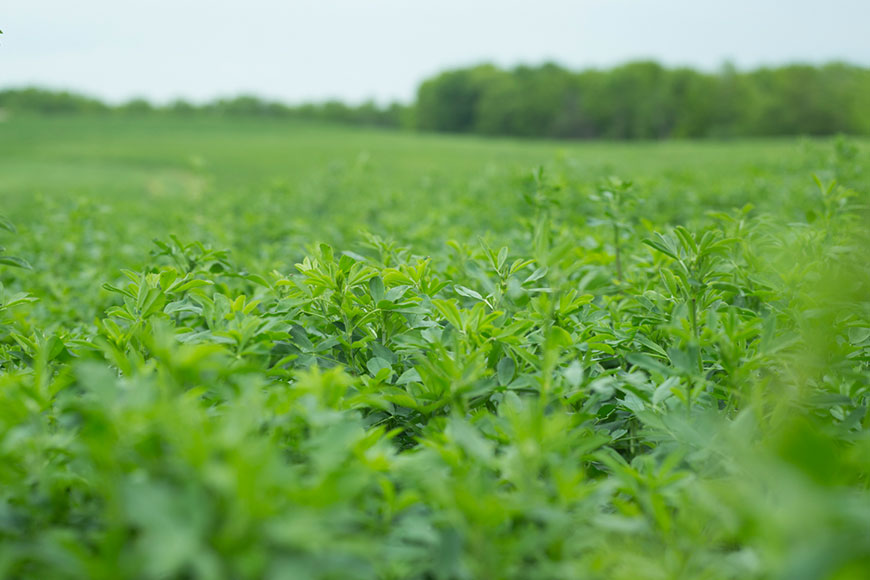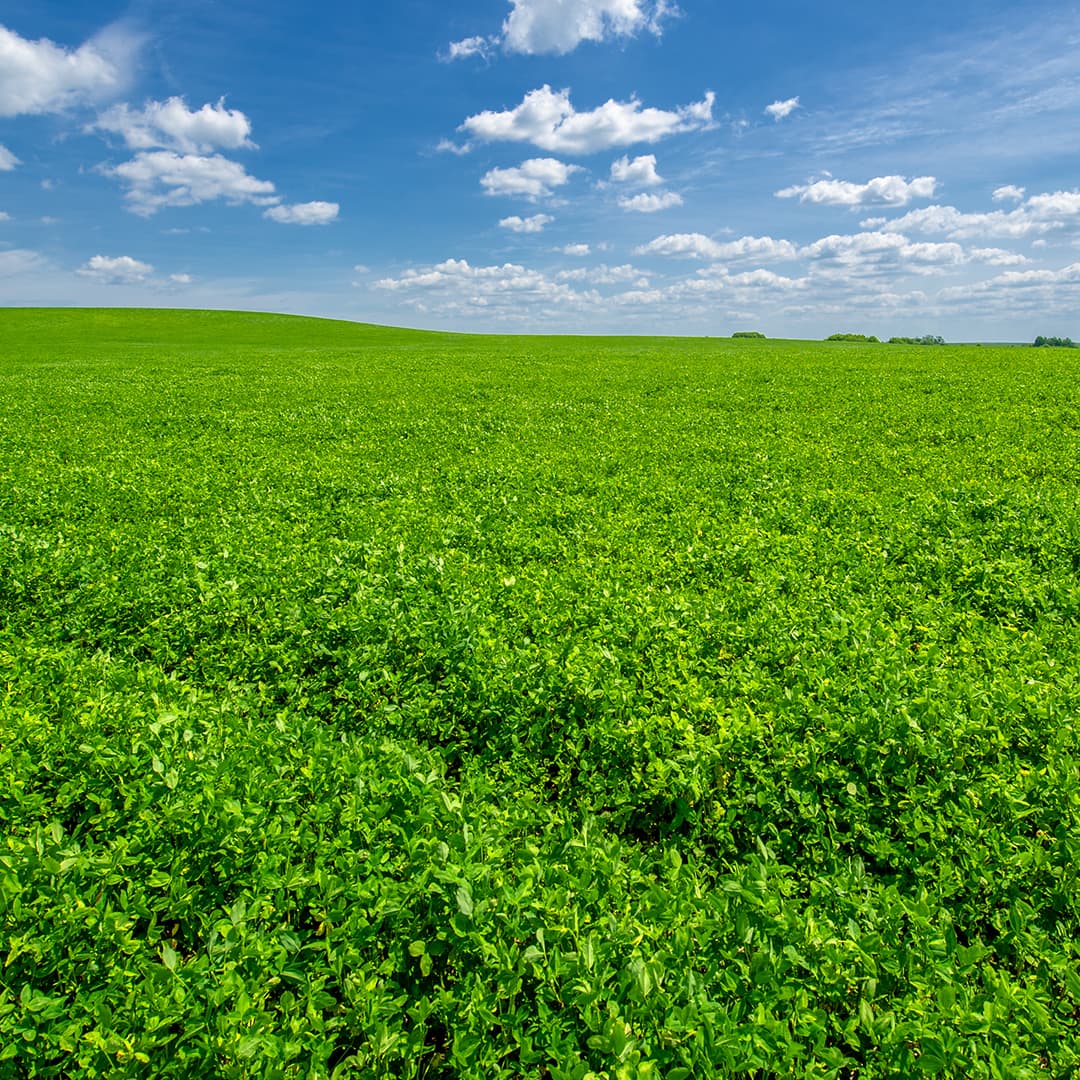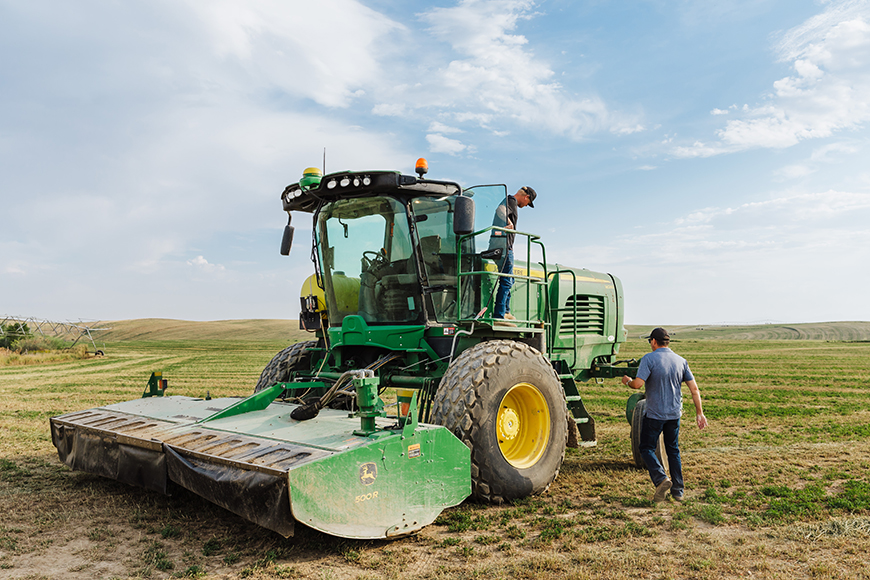Much of the U.S. seeds alfalfa in the fall after a small grain or other crop. These seedings are generally successful if a few key considerations are taken.
Most practices are the same for spring and fall seeding (actually late summer since most seedings should occur in August). Thus, the same seeding rate of the same seed coated with Apron and Stamina are recommended. The same varieties would also be recommended with selection based on soil types and intended use.
When doing a fall planting, first survey the field for weed population. Hopefully, most weed populations will be low if they have been adequately controlled in the previous crop. If this is not the case, it may be necessary for some tillage or herbicide application prior to seeding to allow the young alfalfa seedlings to become established.
Second, consider the history of herbicide applications to the previous crop. Herbicide carryover is a significant cause of alfalfa stand failure. Many herbicides have longer residuals, for example an herbicide with 10 month no-plant window applied to wheat in the spring or an herbicide with 18 to 24 month no-plant window applied to a crop of corn or soybeans the preceding year will often have carryover.
Third, consider the soil moisture of the field. With drought conditions persisting prominently across the country, it is critical to evaluate moisture availability prior to seeding. Seeding alfalfa into a dry soil is acceptable if irrigation is available or rain is expected. However, if lack of rain causes the soil to remain dry and delay alfalfa germination by several weeks, the seedlings may not establish in sufficient time to store energy reserves to survive the winter.
Determine how much moisture is available per foot of soil according to the soil type. As a general guideline, if there is not a profile built up within the upper 2 feet of soil on a dryland acre, a new fall seeding will have little success of survival unless the new developing taproot has moisture access. Pre-watering with a pivot is ideal, but in instances where there is no irrigation, rain is needed to replenish moisture levels within the soil profile. If moisture is not available, growers should consider waiting until spring when there are generally more rainfall events in May and June.
We generally recommend that alfalfa be established about 6 weeks before a killing frost. Alfalfa is perennated and will survive the winter when a crown has formed. This can begin as early as 1 week after emergence but is more likely to take 15 to 16 weeks. The crown is formed when it contracts and pulls the lower buds below ground. One can feel the crown when there is a slight ridge between the top growth and the roots.
The only real difference between spring and fall seeding alfalfa is that a companion crop or weeds will slow establishment and increase the chance of stand failure. While companion crops are not a general recommendation for fall seeded alfalfa in many areas, the use of companion crops or residue on highly erodible soil prone to wind and water erosion may be recommended for late summer and fall seeded alfalfa in some areas where harsh wind events are a common occurrence.
Further, weeds germinating with the seedling alfalfa must be controlled. A common problem when alfalfa is seeded following small grain is that there will be volunteer small grain plants. These must be controlled if a good stand is desired. Consider that each wheat plant germinating with the alfalfa will leave a 4-to 6-inch area with no alfalfa plants. Control is recommended with as little as one volunteer small grain per yard. These volunteer small grains can be readily controlled with a grass herbicide. However, it is generally advantageous to plant Roundup Ready alfalfa and control weeds with glyphosate since both the small grain and any broad leaf weeds will be controlled.
Most practices are the same for spring and fall seeding (actually late summer since most seedings should occur in August). Thus, the same seeding rate of the same seed coated with Apron and Stamina are recommended. The same varieties would also be recommended with selection based on soil types and intended use.
When doing a fall planting, first survey the field for weed population. Hopefully, most weed populations will be low if they have been adequately controlled in the previous crop. If this is not the case, it may be necessary for some tillage or herbicide application prior to seeding to allow the young alfalfa seedlings to become established.
Second, consider the history of herbicide applications to the previous crop. Herbicide carryover is a significant cause of alfalfa stand failure. Many herbicides have longer residuals, for example an herbicide with 10 month no-plant window applied to wheat in the spring or an herbicide with 18 to 24 month no-plant window applied to a crop of corn or soybeans the preceding year will often have carryover.
Third, consider the soil moisture of the field. With drought conditions persisting prominently across the country, it is critical to evaluate moisture availability prior to seeding. Seeding alfalfa into a dry soil is acceptable if irrigation is available or rain is expected. However, if lack of rain causes the soil to remain dry and delay alfalfa germination by several weeks, the seedlings may not establish in sufficient time to store energy reserves to survive the winter.
Determine how much moisture is available per foot of soil according to the soil type. As a general guideline, if there is not a profile built up within the upper 2 feet of soil on a dryland acre, a new fall seeding will have little success of survival unless the new developing taproot has moisture access. Pre-watering with a pivot is ideal, but in instances where there is no irrigation, rain is needed to replenish moisture levels within the soil profile. If moisture is not available, growers should consider waiting until spring when there are generally more rainfall events in May and June.
We generally recommend that alfalfa be established about 6 weeks before a killing frost. Alfalfa is perennated and will survive the winter when a crown has formed. This can begin as early as 1 week after emergence but is more likely to take 15 to 16 weeks. The crown is formed when it contracts and pulls the lower buds below ground. One can feel the crown when there is a slight ridge between the top growth and the roots.
The only real difference between spring and fall seeding alfalfa is that a companion crop or weeds will slow establishment and increase the chance of stand failure. While companion crops are not a general recommendation for fall seeded alfalfa in many areas, the use of companion crops or residue on highly erodible soil prone to wind and water erosion may be recommended for late summer and fall seeded alfalfa in some areas where harsh wind events are a common occurrence.
Further, weeds germinating with the seedling alfalfa must be controlled. A common problem when alfalfa is seeded following small grain is that there will be volunteer small grain plants. These must be controlled if a good stand is desired. Consider that each wheat plant germinating with the alfalfa will leave a 4-to 6-inch area with no alfalfa plants. Control is recommended with as little as one volunteer small grain per yard. These volunteer small grains can be readily controlled with a grass herbicide. However, it is generally advantageous to plant Roundup Ready alfalfa and control weeds with glyphosate since both the small grain and any broad leaf weeds will be controlled.



